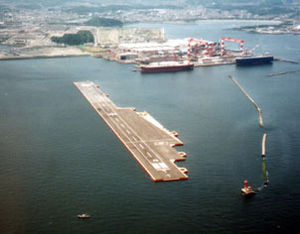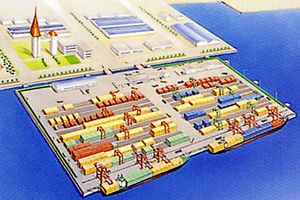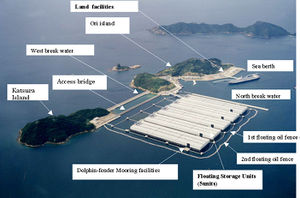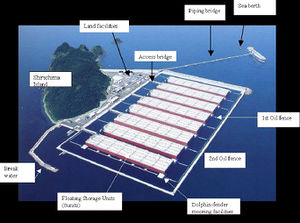Difference between revisions of "VLFS"
| (3 intermediate revisions by 2 users not shown) | |||
| Line 1: | Line 1: | ||
| + | {{pages to be deleted}} | ||
| + | |||
VLFS stands for a very large floating structure. Essentially these are large (larger than the biggest ships) structures | VLFS stands for a very large floating structure. Essentially these are large (larger than the biggest ships) structures | ||
which are proposed to be built for offshore storage platforms, floating airports etc. The most famous example | which are proposed to be built for offshore storage platforms, floating airports etc. The most famous example | ||
| Line 18: | Line 20: | ||
a great deal of the research on floating plates has been motivated by the application | a great deal of the research on floating plates has been motivated by the application | ||
to VLFS. Also, because of the large size, the problem is often extremely computationally | to VLFS. Also, because of the large size, the problem is often extremely computationally | ||
| − | demanding, especially at high frequencies. This has | + | demanding, especially at high frequencies. This has led to the development of special approximations |
focused on the high frequency limit. | focused on the high frequency limit. | ||
| − | There has been extensive research on VLFS in Japan, and this research is | + | There has been extensive research on VLFS in Japan, and this research is summarized in |
the review articles [[Kashiwagi 2000]] and [[Watanabe, Utsunomiya and Wang 2004]]. | the review articles [[Kashiwagi 2000]] and [[Watanabe, Utsunomiya and Wang 2004]]. | ||
[[Category:Offshore Engineering]] | [[Category:Offshore Engineering]] | ||
Latest revision as of 00:17, 17 October 2009
VLFS stands for a very large floating structure. Essentially these are large (larger than the biggest ships) structures which are proposed to be built for offshore storage platforms, floating airports etc. The most famous example is the megafloat built as a prototype floating airport near Tokyo, Japan.
Other examples of megafloats include the proposed floating container terminal, Kamigoto oil storage facility at Nagasaki, and Shirasima oil storage facility at Kitakyusyu, Japan.
There are many hydrodynamic challenges to understanding the motion of such structures. Most significantly, because of the large size, it is not possible to model the structure as rigid and allowance must be given for the bending moments. The simplest model for a VLFS is a Floating Elastic Plate and a great deal of the research on floating plates has been motivated by the application to VLFS. Also, because of the large size, the problem is often extremely computationally demanding, especially at high frequencies. This has led to the development of special approximations focused on the high frequency limit.
There has been extensive research on VLFS in Japan, and this research is summarized in the review articles Kashiwagi 2000 and Watanabe, Utsunomiya and Wang 2004.



